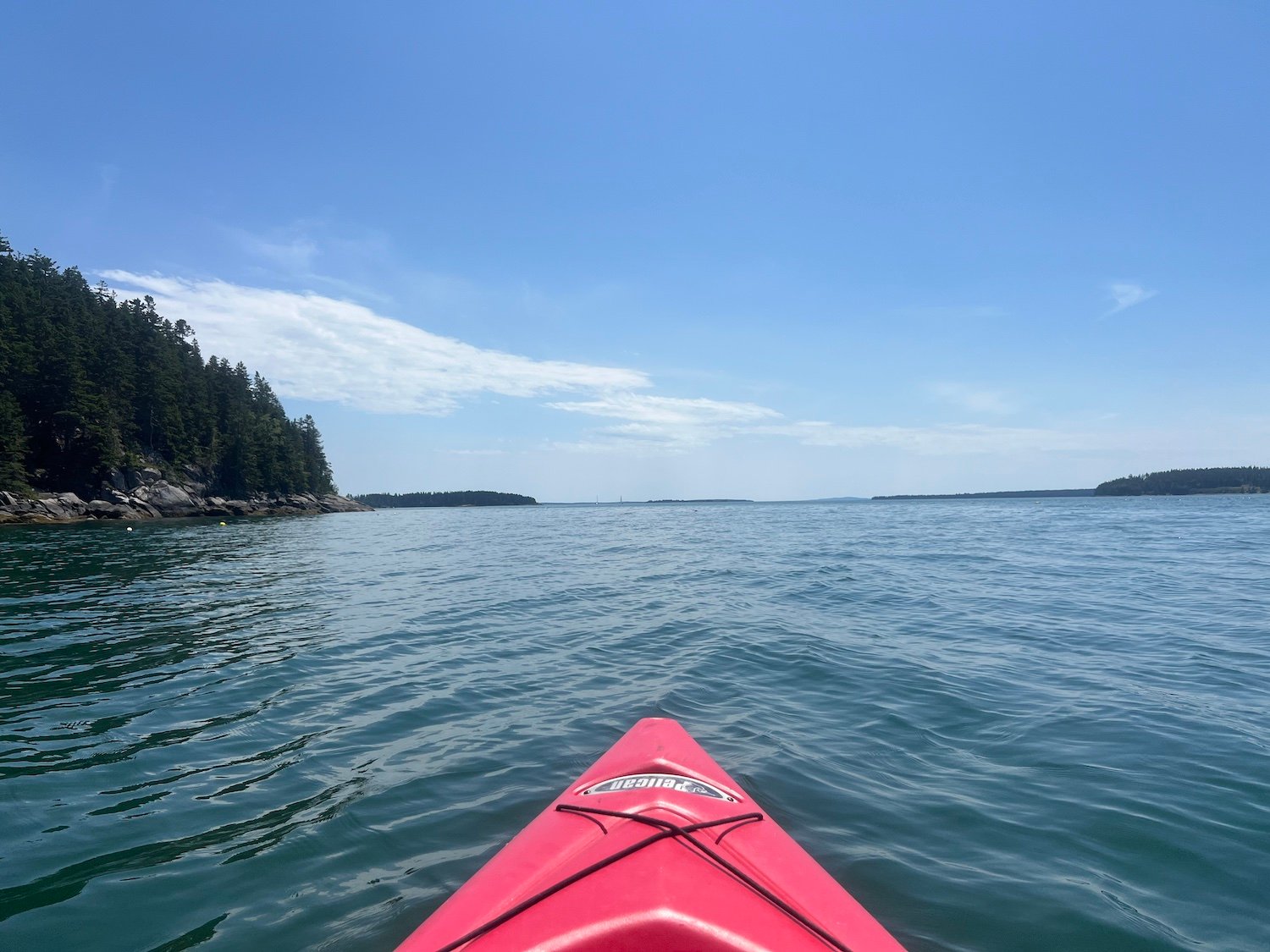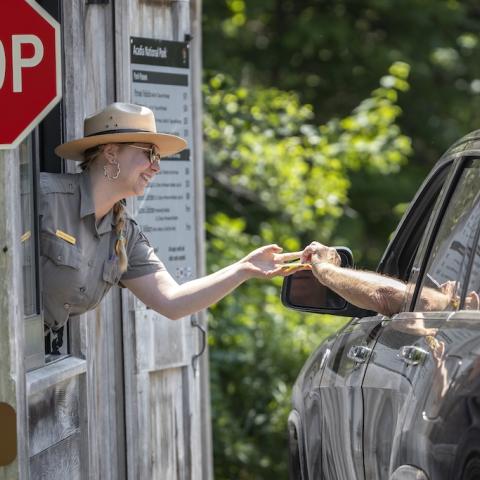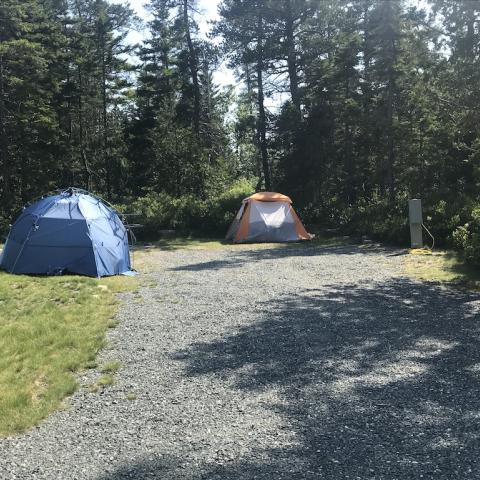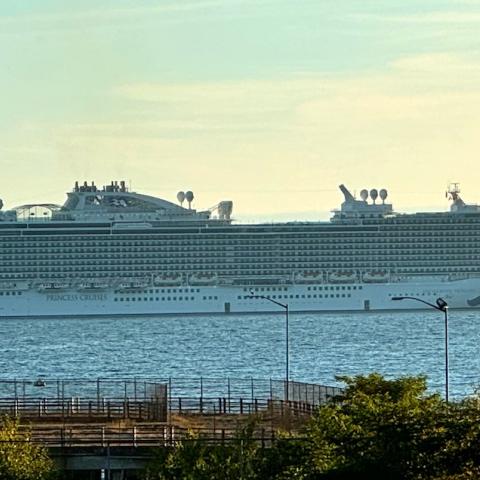A harbor porpoise’s thin, gray dorsal fin shot through the undulating sea water less than 100 feet from my kayak off the coast of Mount Desert Island (MDI) in Maine. I spotted it while paddling along the southwestern edge of the island in late July, with a slow-moving current under my boat and cool breeze in the air. Less than a minute later, its curved dorsal fin disappeared below the water and then reappeared yards further away from me, repeating the movement several times as it swam west toward a nearby island.
Porpoise are among the numerous wildlife that can be seen while sea kayaking in and around Acadia National Park, which spans much of MDI, the Schoodic Peninsula, Ilse au Haut, and other outlying islands. Many of the park’s 338 species of birds, 30 species of fish, seven species of reptiles, countless invertebrates, and other fauna reside along or near its 64 miles of coastline, according to the National Park Service.
Throughout the summer, paddlers of all skill levels traverse harbors, bays, narrows, and coves to witness diverse fauna and flora and the picturesque landscape they call home. Trained adventurers and companies offer guided trips to scour for wildlife watching, sometimes during twilight, that can last from a couple of hours to overnight.
“The diversity in the wildlife you’re going to find is very surprising. Some places don’t have as many birds or aquatic life as we do,” said Jacob Clark, a friend and registered Maine guide who took me and my wife on the July kayaking trip around Acadia.
Seals, Seabirds And Shellfish
We saw porpoise and other wildlife during a four-mile trip across the Mount Desert Narrows and Blue Hill Bay from Pretty Marsh Picnic Area southward to Seal Cove. An extensive tidal cycle that causes ocean levels to rise and fall eight-to-12 feet over 12-hour intervals can greatly affect a paddling trip. We launched from Pretty Marsh at the end of a tidal cycle, and coupled with zero fog, a predominantly smooth current, and lack of strong winds, conditions were ripe for extensive wildlife watching both above and below the water surface. Also playing in our favor was our route around what many, even the national park’s staff, have deemed the quieter western side of Acadia.
“I particularly liked the western side of MDI just because of the coverage you have, and it seemed to offer more wildlife encounters than the other areas because (that’s where) you have more foot traffic, or boat traffic or it’s just not an area where they settle,” Clark said.
Amid the backdrop of a rugged, pine-tree-covered coastline and small rocky islands and outcrops, we saw water fowl, migratory birds, raptors and even a seal. Both harbor and gray seals reside in Acadia, but as explained by Park Service, the darker, longer and more horse-shaped head indicated that it was the latter that swam many yards from us.
“We’ve seen this amazing and incredible resurgence of seals because we have more fish than we have had before. We have more alewives, we have more Menhaden, we have more fish that seals like to eat, so that’s fabulous,” said Hannah Webber, marine ecology director of the Schoodic Institute based on Acadia’s Schoodic Peninsula, told me after I got off the water. “You will see both species while out sea kayaking in Frenchman Bay and Blue Hill Bay. And we see them while we’re out doing our work.”
Seals are best appreciated from a distance while sea kayaking — federal law requires paddlers to stay 150 feet from them.
“It is super stressful for seals if you are approaching them,” Webber said. “So if you want to see a seal and you want to get that glory shot, really a telephoto lens is your best friend. If you’re not a camera person, binocs are really your best friend.”
Sonorous and solemn loon calls sporadically filled the air as we kayaked through the bay. We found one loon bobbing up in down with billowing current, unaffected by our presence.

A loon floats on the waters of Blue Hill Bay off the coast of Mount Desert Island/Marcus Wolf
Trip Of A Lifetime: Exploring Glacier Bay National Park And Preserve By Kayak
Throughout our trip, we also saw dozens of Double-crested cormorants, which, as described by Cornell University, are brown-black waterbirds that have long necks and stand between two and three feet tall, perched atop of buoys and small rocky outcrops in the water. Halfway through the voyage, we stopped by a small island with cormorants, gulls, and common terns, small white birds with a partial black cap, bright orange beak and forked tail. They flew around, flapped their wings and cawed at each other.
The beaches and islands surrounding Acadia are also home to variety of duck species, the most populous of which being the common eider, said Maine Audubon naturalist Doug Hitchcox. Additionally, paddlers can see Black guillemots, black seabirds with big white wing patches that are a cousin of the Atlantic puffin. The rocky outshore islands attract many these birds, as they provide them with suitable nesting habitats. Hitchcox says you can paddle up to and marvel at them until they notice your presence and make eye contact.
“I always find that from a boat, you just such a kind of a unique perspective, and especially with some of the birds that are otherwise pretty far away,” he said. “You’re reducing the threat level … where you can often get a lot closer to some of these birds that otherwise might be a little flighty to the human silhouette by shore.”
About halfway into our trip around southwest MDI, Clark led us into a small cove with a pebble beach bordered by conifers. We could see countless snails and clams attached to or tucked between rocks below the still water. Clark even spotted a bioluminescent moon jelly, a small, translucent fish with fringe-like tentacles that glow, according to the National Aquarium. Pulling ashore on a beach covered in various shells, Clark grabbed a rock covered with barnacles.

Barnacles attached to a rock on a pebble beach on Mount Desert Island/Marcus Wolf
“I always get really excited when I see fish and clams and mussels and crabs, because I didn’t see a lot of that growing up,” Clark said. “A lot of those animals will crawl up the beach during high tide to look for food or a place to shelter — or just a place to test it while they filter feed — and at low tide, they’re all exposed because the tide drops 12 feet down, which could be about 50-60 feet (more exposed beach) out from the high tide line."
We also paddled over sprawling kelp beds in the briny bay, which we were able to peer through the murky water thanks to the mild current. These kelp beds and mud flats in the area offer windows into “oases of diversity,” Webber said. Kelp beds, in particular, serve as food sources and hiding places for pollock, lumpfish and other fish. Tidal height and water clarity play critical roles in determine whether paddlers can clearly see below the waves.
“They are absolutely marvelous,” Webber said. “Kelp are subtidal, and so it’s lovely to be paddling over a kelp bed and explore what’s beneath you.”
Exploring The Other Side Of Yellowstone By Sea Kayak
Easy And Safe Access
MDI offers several public boat launches from which to sea kayak, including ramps in Bar Harbor, Northeast Harbor and Southwest Harbor and sites in Seal Cove, Bass Harbor, Seal Harbor Beach and Hadley Point, according to the Park Service. There is also a picnic area on Frazer Point along the Schoodic Peninsula, which Webber said also features kelp beds.
“I think a beginner should stick to the west side of MDI because there’s a nice channel where if they get tired or lost, there’s land right around them,” Clark said. “It’s a good stomping ground — probably more up toward Trenton near Indian Point and Town Hill — because that’s almost like a little bay where they can just feel how the tides and the wind are moving them around; like a little training ground.”
Additionally, novice kayakers should avoid paddling through fog, high winds, and conditions that result in fast-moving currents.
“Having that experience with someone who knows what they’re doing can alleviate some serious concerns and teach you some valuable skills to be able to navigate those areas,” Clark said. “It’s also important to know the conditions, and a Maine sea kayak guide will know how to prepare for whatever excursion you want to do.”

Birdlife is ever present as you kayak around Acadia. These gulls had claimed a small island in Blue Hill Bay/Marcus Wolf
In The Wake Of A Warming World
While I couldn’t see the immediate signs during our kayaking trip, climate change does pose serious threats for the wildlife in and around Acadia, as they do elsewhere worldwide. The Gulf of Maine is warming faster than 99 percent of the global ocean, according to the Gulf of Maine Research Institute, and that can alter the ecosystem dynamics in various ways, albeit ones that can be hard to predict.
While rising sea temperatures have made the gulf more habitable for seals, they have also ushered in more sharks and invasive species from the south, like poisonous lionfish, Webber said. Invasive species can consume seaweed and other valuable resources that native species rely on, threatening their viability. In previous years, warming waters allowed invasive green crabs to inhabit the gulf, which Webber said devastated softshell claim populations.
“It’s not only a warming ocean. It’s an acidifying ocean,” Webber said, “and that’s made other kind of changes happening synergistic with warming waters.”
According to the Park Service, rising sea temperatures are altering tidepool ecosystems, and increasing acidity can inhibit clams and snails from forming shells. Bird populations are also declining as a result of climate change with some species — like boreal chickadees — no longer breeding in the park. Hitchcox said while some birds are moving northward to colder climates as their homes warm, southern species are also relocating to the region for the same reason.
“We definitely know forests are shifting a little bit in their composition, but definitely not as fast as the birds are shifting,” Hitchcox said. “It still looks like great habitat for a boreal chickadee, but then it kind of leads into the question like, ‘Okay, what’s changed that makes it not ideal for them?'”
While climate change continues sparking fear and concern, signs of hope can still be found along the coast of Acadia, even from a sea kayak. Near the end of our journey, as the current picked up and we pushed head-on into the waves to keep ourselves from tipping over, I spotted an eagle perched atop a pine tree on a ridge and an osprey circling overhead.
The continued presence of these species in the park and across the country is possible through conservation, particularly the Endangered Species Act of 1973, according to Hitchcox. Many of the islands around Acadia that birds rely on for nesting are protected land. Collaborative studies conducted by local researchers employed by the Schoodic Institute, other organizations, and federal agencies support monitoring efforts that could protect wildlife for years to come.
“It’s kind of funny to think if someone was on a sea kayaking trip around Acadia, if it wasn’t for conservation work, it would be a boring trip,” Hitchcox said. “It’d be a dull ride.”






 Support Essential Coverage of Essential Places
Support Essential Coverage of Essential Places







Comments
This was a fantastic article. Learned so much about the coastline and its habitat. Glad to read about the changes in the climate that seems to be affecting more than most people know. Great writing, Marcus Wolf.